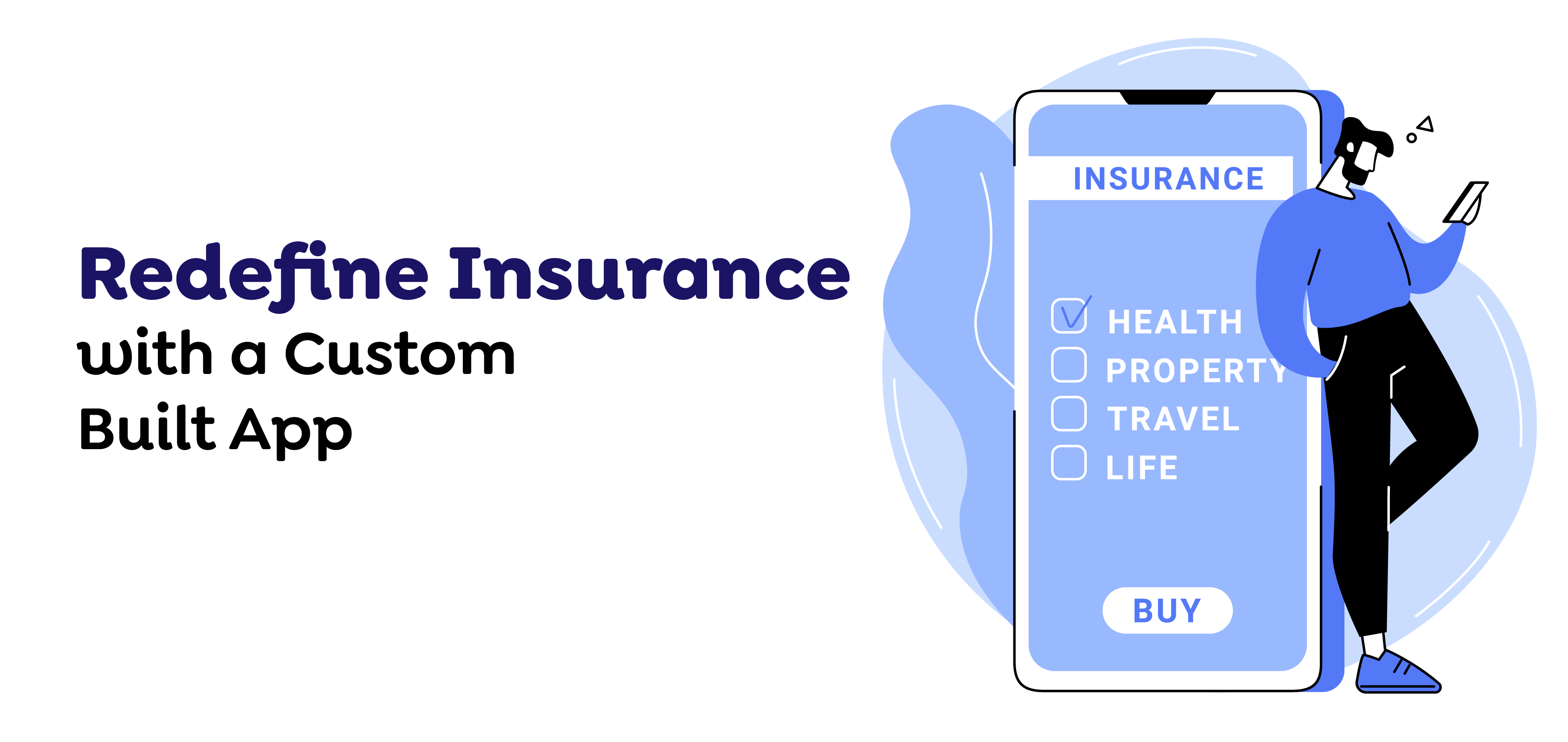Write Us
We are just a call away
[ LET’S TALK AI ]
X
Discover AI-
Powered Solutions
Get ready to explore cutting-edge AI technologies that can transform your workflow!


After the COVID-19 crisis, people have become a little more concerned about their security. Thus, the world of insurance has acquired immense popularity because innovation is now reshaping every industry. As the demand for convenient, accessible, and customizable insurance solutions continues to grow, building an insurance app has become an enticing proposition for entrepreneurs and established companies alike.
If you’re intrigued by the idea of crafting your own insurance app or simply curious about the process, you’ve come to the right place. In this comprehensive guide, we will take on a journey through the intricate landscape of insurance mobile app development, from concept to code, and beyond.
 According to a Statista research, the global insurance market is likely to grow over $8.4 trillion mark by the end of 2026. While the insurtech industry is relatively new that amalgamates insurance and technology, it is a rapily evolving sphere. Sure, these are the primary reasons to build an insurance mobile app for your business. However, this is not it!
According to a Statista research, the global insurance market is likely to grow over $8.4 trillion mark by the end of 2026. While the insurtech industry is relatively new that amalgamates insurance and technology, it is a rapily evolving sphere. Sure, these are the primary reasons to build an insurance mobile app for your business. However, this is not it!
Take a look at some of the top-notch benefits that are inclining the industry towards insurtech innovation:
Insurance apps bring convenience to policyholders like never before. Customers can access their policy information, submit claims, make payments, and even get quotes right from their smartphones. This 24/7 accessibility caters to the modern, on-the-go lifestyle, ensuring that customers have the information they need at their fingertips. This level of convenience enhances customer satisfaction and loyalty.
One of the most significant advantages of insurance mobile app development is the ability to streamline the claims process. Policyholders can file claims through the app, attaching necessary documentation such as photos or videos, eliminating the requirement for lengthy paperwork and manual processing. Insurers can also use data analytics to expedite claims assessment, leading to quicker payouts and improved customer trust.
Insurance apps enable insurers to gather more data about their policyholders’ behavior and preferences. With this data, insurers can offer personalized coverage options tailored to the individual needs of each customer. Personalization not only improves customer satisfaction but can also lead to increased policy sales and retention rates.
For insurance companies, digitizing processes through app development can result in significant cost savings. It reduces the need for physical paperwork, manual data entry, and administrative overhead. Furthermore, automated processes and data analytics can help insurers identify and mitigate risks more effectively, reducing overall claims payouts.
Insurance apps provide a direct communication channel between insurers and policyholders. Companies can send important updates, policy renewal reminders, and personalized offers through push notifications. This improved communication fosters engagement and helps insurers stay connected with their customers.
Advanced technology, such as artificial intelligence and machine learning, can be integrated into insurance apps to detect and prevent fraud. These tools can analyze data patterns to identify potentially fraudulent claims or activities, ultimately saving insurance companies significant sums of money.
Investing in insurance app development can set insurers apart in a highly competitive market. Customers increasingly expect the convenience and accessibility that apps provide, and companies that fail to deliver may struggle to attract and retain clients. By offering a user-friendly and feature-rich app, insurers can gain a competitive edge.
Insurance apps generate valuable data that insurers can use to refine their offerings and pricing models. By analyzing user behavior within the app, companies can gain insights into customer preferences, pain points, and needs. This data-driven approach can inform business strategies and lead to more informed decision-making.
Insurance apps can be designed to ensure compliance with industry regulations and data protection standards. This reduces the risk of regulatory fines and penalties, providing insurers with peace of mind as they navigate the complex landscape of insurance laws and regulations.
To dive deeper into the insights of developing an insurance app, partner with an incredible fintech app development company.
 Insurance apps have revolutionized the way we interact with the insurance industry, offering convenience, accessibility, and personalized services. These digital solutions cater to various insurance needs, both for individuals and businesses. Here, we delve into the different types of insurance apps and their unique functionalities:
Insurance apps have revolutionized the way we interact with the insurance industry, offering convenience, accessibility, and personalized services. These digital solutions cater to various insurance needs, both for individuals and businesses. Here, we delve into the different types of insurance apps and their unique functionalities:
Personal insurance apps are designed for individual policyholders and cover a wide range of insurance products, including auto insurance apps, health insurance apps, life insurance apps, and home insurance apps.
Commercial insurance apps cater to businesses and organizations seeking insurance coverage for various needs, such as commercial auto insurance apps, business insurance apps, and professional liability insurance apps.
Some insurance apps focus on specific niches or types of coverage, like travel insurance apps, pet insurance apps, and crop insurance apps.
Comparison and marketplace apps enable users to compare insurance quotes from various providers and choose the best coverage for their needs.
Telematics-based apps gather data from sensors in vehicles or connected devices to assess policyholders’ driving behavior or usage patterns. This data is then used to calculate premiums.
Claims processing apps focus on making the claims submission and processing experience more efficient. These apps enable policyholders to submit claims easily, often allowing them to upload photos or documents as supporting evidence. Additionally, Users can track the status of their claims and receive updates on the progress, enhancing transparency and communication.
InsurTech startups are developing innovative apps that leverage technologies such as artificial intelligence (AI), machine learning, and blockchain to disrupt traditional insurance processes.
Super apps are the combination of multiple functionalities or services under one platform. Talking about insurance super apps, these include marketplace, claims, management, learning apps, and more.
 No wonder, more and more people are now using insurance app due to the convenience and seamlessness it provides. But what makes the process hassle-free?
No wonder, more and more people are now using insurance app due to the convenience and seamlessness it provides. But what makes the process hassle-free?
Take a look at some of the terrific features that work as a pixie dust upon infusing with the app:
– Policy Information Access: Users can view their policy details, including coverage, premiums, deductibles, and renewal dates. This feature allows policyholders to stay informed about their insurance arrangements.
– Policy Issuance: The app can facilitate the issuance of new policies. Users can apply for coverage, receive quotes, and complete the purchase process seamlessly.
– Claims Submission: Policyholders can submit claims directly through the app. They can attach relevant documents, such as photos or receipts, to support their claim.
– Real-Time Updates: Users can receive updates on the status of their claims. This transparency improves customer satisfaction by keeping policyholders informed throughout the claims process.
– Online Payments: The app should allow policyholders to pay their premiums online. This feature ensures that payments are made conveniently and on time, reducing lapses in coverage.
– Payment Reminders: Users can set up payment reminders, reducing the likelihood of missed payments.
Indeed, the fintech industry is playing a tremendous role in fulfilling its clientele’s demand!
– User Authentication: Secure user authentication methods, such as biometrics or two-factor authentication (2FA), ensure that only authorized individuals can access sensitive insurance information.
– Digital ID Cards: Users can access digital versions of their insurance ID cards, making it easy to provide proof of coverage when necessary.
– In-App Messaging: Policyholders can communicate with customer support representatives directly within the app, seeking assistance or clarification on their policies and claims.
– Push Notifications: The app can send important notifications to users, such as policy updates, renewal reminders, or weather-related alerts that might impact coverage.
Using data analytics, insurers can provide tailored insurance product recommendations to users based on their profiles and needs.
Users can upload important documents related to their policies, such as contracts or medical records, for safekeeping and easy access.
The app can use GPS technology to provide location-specific information, such as nearby network hospitals or auto repair shops in case of an accident.
For global or diverse customer bases, offering the app in multiple languages ensures accessibility and inclusivity.
– Data Encryption: Ensuring that sensitive user data is encrypted and securely stored is paramount to maintaining user trust and meeting the data protection regulations.
– Compliance Tools: The app can incorporate features to help insurers adhere to industry-specific regulations and compliance standards.
Users should be able to access certain essential functions of the app even when they have limited or no internet connectivity.
Including a feedback and rating system enables users to provide input, helping insurers improve their services and the app itself.
The app can integrate with other services, such as healthcare providers, repair shops, or financial institutions, to facilitate seamless transactions and claims processing.
Insurers can leverage data analytics to gain insights into user behavior, claims trends, and app performance, informing strategic decisions.
 The insurance industry has remarkably adopted digital transformation, and building insurance apps from scratch is a pivotal part of this evolution. These apps offer insurers the opportunity to enhance customer experiences, streamline operations, and stay competitive in a rapidly changing landscape. Take a look at the steps below:
The insurance industry has remarkably adopted digital transformation, and building insurance apps from scratch is a pivotal part of this evolution. These apps offer insurers the opportunity to enhance customer experiences, streamline operations, and stay competitive in a rapidly changing landscape. Take a look at the steps below:
Before diving into development, it’s crucial to define the goals of your insurance app and identify your target audience. Are you focusing on auto insurance, health insurance, life insurance, or a combination? Understanding your audience’s needs and preferences will shape the app’s features and functionalities.
Conduct thorough market research to understand the current fintech trends and demands within the insurance industry. Analyze your competitors’ apps to identify gaps and opportunities for innovation. This knowledge will help you position your app effectively.
Selecting the appropriate technology stack is critical. Consider factors such as the platform (iOS, Android, or cross-platform), programming languages, and development frameworks. The technology stack should align with your app’s objectives and future scalability. For further assistance, connect with a reliable Android or iOS mobile app development company.
Insurance apps deal with sensitive user data, making security and regulatory compliance paramount. Implement robust security measures, including data encryption, secure authentication, and compliance with data protection laws like GDPR or HIPAA if applicable.
The design of your app plays a significant role in user adoption. Create an intuitive and user-friendly interface that simplifies complex insurance processes. Focus on usability, accessibility, and responsiveness across various devices.
Determine the core features of your insurance app based on your objectives. Common features include policy management, claims processing, payment processing, document management, and more.
Consider integrating emerging technologies like artificial intelligence (AI) and machine learning (ML) for tasks like claims assessment and risk analysis. These technologies can enhance efficiency and accuracy.
Thoroughly test your app to identify and fix any bugs or issues. Conduct usability testing to ensure the app meets user expectations. Test the app’s performance under various conditions and devices.
Once your insurance app is ready, plan a strategic launch. Develop a marketing strategy to promote the app to your target audience. Consider using app stores, social media, and digital advertising to reach potential users.
Encourage users to provide feedback through the app. Analyze user data and feedback to identify areas for improvement and new features. Regularly update the app to enhance its functionality and security.
Take a look at the breakdown of cost of building an on-demand insurance app:
The type and complexity of your insurance mobile app development will significantly influence its development cost. Fintech apps can range from simple personal budgeting tools to complex trading platforms or payment gateways. The more features and functionalities your app requires, the higher the development cost is likely to be.
Deciding whether to develop your fintech app for iOS, Android, or both platforms is another cost factor. Building for both platforms typically increases development expenses, as it requires more development and testing time. However, it can also widen your user base.
Creating an intuitive and visually appealing design is crucial for fintech apps, as they deal with sensitive financial information. Investing in a well-thought-out user interface (UI) and user experience (UX) design is essential, and it can impact both the development and design costs.
Fintech apps handle sensitive financial data and must comply with strict security and regulatory standards. Implementing robust security measures and ensuring compliance with data protection laws can significantly add to the development cost. It’s essential not to cut corners on security to protect your users and your reputation.
Many fintech apps rely on third-party integrations for features like payment processing, account aggregation, or data analysis. The cost of integrating with these services can vary based on their complexity and usage.
Fintech apps often require licenses and regulatory approvals, depending on the services they offer and the regions they operate in. These compliance-related expenses can add to the overall cost of development.
Ensuring that your fintech app is bug-free and functions flawlessly is critical. Extensive testing and quality assurance efforts are necessary, and these activities incur costs.
The development cost is just the beginning. You must budget for ongoing maintenance, updates, and enhancements to keep your app competitive and secure. This includes fixing bugs, adding new features, and staying up to date with platform changes.
Now that you are familiar with the cost of building a fintech app, are you all set to move ahead?
The journey of building an innovative insurance app is a dynamic and rewarding endeavor. We’ve explored the essential steps and considerations required to embark on this transformative path. From defining objectives and understanding your target audience to choosing the right technology stack and prioritizing data security, each step plays a vital role in crafting an app that not only meets but exceeds user expectations.
Building an innovative insurance app is not just about creating a digital solution; it’s about transforming an industry, enhancing customer experiences, and making insurance more accessible and efficient for everyone. By embracing innovation, staying attuned to user needs, and remaining agile in the face of change, you can build an insurance app that not only meets the demands of today but also leads the way into the future of insurance.
So, get onboard with a top-notch mobile app development company in USA to begin working on your project.
Write Us
sales@techugo.comOr fill this form